Research on Renewable-Energy Accommodation-Capability Evaluation Based on Time-Series Production Simulations
Abstract
:1. Introduction
- The aggregation model of power grid is proposed, which realizes the optimization of power grid structure, and puts forward corresponding evaluation indicators for the renewable-energy accommodation capability.
- A renewable energy accommodation capability model based on time-series production simulation is proposed, a week-by-week optimization solution is designed, and the hybrid particle swarm optimization algorithm is used to solve the problem, which can quickly obtain the calculation results of long-term accommodation capability.
- The effectiveness and efficiency of the designed renewable energy accommodation capability calculation method are verified by simulation calculations in Matlab.
2. Problem Formulation
2.1. Aggregation Model of the Power Grid
2.2. Evaluation Indicators of Renewable-Energy Accommodation Capability
2.3. Calculation Method
3. Modelling Renewable-Energy Accommodation Capabilities
3.1. Conventional Unit Model
3.2. Renewable-Energy Model
3.3. Optimization Model
4. Case Analysis
4.1. Boundary Conditions
4.2. Analysis of Simulation Results
5. Conclusions
Author Contributions
Funding
Data Availability Statement
Conflicts of Interest
References
- Huang, Z.; Huang, L. Individual new energy consumption and economic growth in China. N. Am. J. Econ. Financ. 2020, 54, 101010. [Google Scholar] [CrossRef]
- Xue, F.; Feng, X.; Liu, J. Influencing Factors of New Energy Development in China: Based on ARDL Cointegration and Granger Causality Analysis. Front. Energy Res. 2021, 9, 475. [Google Scholar] [CrossRef]
- Xu, X.L.; Qiao, S.; Chen, H.H. Exploring the efficiency of new energy generation: Evidence from OECD and non-OECD countries. Energy Environ. 2020, 31, 389–404. [Google Scholar] [CrossRef]
- Su, X.; Bai, X.; Liu, C.; Zhu, R.; Wei, C. Research on Robust Stochastic Dynamic Economic Dispatch Model Considering the Uncertainty of Wind Power. IEEE Access 2019, 7, 147453–147461. [Google Scholar] [CrossRef]
- Dingbang, C.; Cang, C.; Qing, C.; Lili, S.; Caiyun, C. Does new energy consumption conducive to controlling fossil energy consumption and carbon emissions?—Evidence from China. Resour. Policy 2021, 74, 102427. [Google Scholar] [CrossRef]
- Moretti, L.; Astolfi, M.; Vergara, C.; Macchi, E.; Pérez-Arriaga, J.I.; Manzolini, G. A design and dispatch optimization algorithm based on mixed integer linear programming for rural electrification. Appl. Energy 2019, 233–234, 1104–1121. [Google Scholar] [CrossRef]
- Haghighat Mamaghani, A.; Avella Escandon, S.A.; Najafi, B.; Shirazi, A.; Rinaldi, F. Techno-economic feasibility of photovoltaic, wind, diesel and hybrid electrification systems for off-grid rural electrification in Colombia. Renew. Energy 2016, 97, 293–305. [Google Scholar] [CrossRef]
- Fang, D.; Guan, X.; Peng, Y.; Chen, H.; Ohtsuki, T.; Han, Z. Distributed Deep Reinforcement Learning for Renewable Energy Accommodation Assessment With Communication Uncertainty in Internet of Energy. IEEE Internet Things J. 2021, 8, 8557–8569. [Google Scholar] [CrossRef]
- Lin, L.; Guan, X.; Hu, B.; Li, J.; Wang, N.; Sun, D. Deep reinforcement learning and LSTM for optimal renewable energy accommodation in 5G internet of energy with bad data tolerant. Comput. Commun. 2020, 156, 46–53. [Google Scholar] [CrossRef]
- Hou, L.; Li, W.; Zhou, K.; Jiang, Q. Integrating flexible demand response toward available transfer capability enhancement. Appl. Energy 2019, 251, 113370. [Google Scholar] [CrossRef]
- Sobhy, A.; Megahed, T.F.; Abo-Zahhad, M. Overhead transmission lines dynamic rating estimation for renewable energy integration using machine learning. Energy Rep. 2021, 7, 804–813. [Google Scholar] [CrossRef]
- Zhou, X.; Ma, Y.; Wang, H.; Li, Y.; Yu, J.; Yang, J. Optimal scheduling of integrated energy system for low carbon considering combined weights. Energy Rep. 2022, 8, 527–535. [Google Scholar] [CrossRef]
- Bu, Y.; Zhang, X. On the Way to Integrate Increasing Shares of Variable Renewables in China: Activating Nearby Accommodation Potential under New Provincial Renewable Portfolio Standard. Processes 2021, 9, 361. [Google Scholar] [CrossRef]
- Liu, P.; Chu, P. Wind power and photovoltaic power: How to improve the accommodation capability of renewable electricity generation in China? Int. J. Energy Res. 2018, 42, 2320–2343. [Google Scholar] [CrossRef]
- Liu, Y.; Guan, X.; Li, J.; Sun, D.; Ohtsuki, T.; Hassan, M.M.; Alelaiwi, A. Evaluating smart grid renewable energy accommodation capability with uncertain generation using deep reinforcement learning. Future Gener. Comput. Syst. 2020, 110, 647–657. [Google Scholar] [CrossRef]
- Dong, Y.; Shan, X.; Yan, Y.; Leng, X.; Wang, Y. Architecture, Key Technologies and Applications of Load Dispatching in China Power Grid. J. Mod. Power Syst. Clean Energy 2022, 10, 316–327. [Google Scholar] [CrossRef]
- Luo, L.; Abdulkareem, S.S.; Rezvani, A.; Miveh, M.R.; Samad, S.; Aljojo, N.; Pazhoohesh, M. Optimal scheduling of a renewable based microgrid considering photovoltaic system and battery energy storage under uncertainty. J. Energy Storage 2020, 28, 101306. [Google Scholar] [CrossRef]
- You, F.; Si, X.; Dong, R.; Lin, D.; Xu, Y.; Yang, Y.; Yang, D. A State-of-Charge-Based Flexible Synthetic Inertial Control Strategy of Battery Energy Storage System. Front. Energy Res. 2022, 603. [Google Scholar] [CrossRef]
- Al-Shetwi, A.Q.; Hannan, M.; Jern, K.P.; Mansur, M.; Mahlia, T. Grid-connected renewable energy sources: Review of the recent integration requirements and control methods. J. Clean. Prod. 2020, 253, 119831. [Google Scholar] [CrossRef]
- Bakhshaei, P.; Askarzadeh, A.; Arababadi, R. Operation optimization of a grid-connected photovoltaic/pumped hydro storage considering demand response program by an improved crow search algorithm. J. Energy Storage 2021, 44, 103326. [Google Scholar] [CrossRef]
- Wang, X.; Liu, S.; Wang, R.; Liu, C.; Zhao, Y.; Hu, Y.; Chen, Q. Research on dynamic characteristics and stability of MMC photovoltaic grid-connected system based on rotational synchronous generator model. Electr. Power Syst. Res. 2019, 173, 183–192. [Google Scholar] [CrossRef]
- Lin, H.; Wang, C.; Wen, F.; Tseng, C.L.; Hu, J.; Ma, L.; Fan, M. Risk-Limiting Real-Time Economic Dispatch in a Power System with Flexibility Resources. Energies 2019, 12, 3133. [Google Scholar] [CrossRef]
- Yu, C.; Lai, X.; Chen, F.; Jiang, C.; Sun, Y.; Zhang, L.; Wen, F.; Qi, D. Multi-Time Period Optimal Dispatch Strategy for Integrated Energy System Considering Renewable Energy Generation Accommodation. Energies 2022, 15, 4329. [Google Scholar] [CrossRef]
- Qu, M.; Ding, T.; Huang, L.; Wu, X. Toward a Global Green Smart Microgrid: An Industrial Park in China. IEEE Electrif. Mag. 2020, 8, 55–69. [Google Scholar] [CrossRef]
- Chamandoust, H.; Derakhshan, G.; Hakimi, S.M.; Bahramara, S. Tri-objective scheduling of residential smart electrical distribution grids with optimal joint of responsive loads with renewable energy sources. J. Energy Storage 2020, 27, 101112. [Google Scholar] [CrossRef]
- Thomas, D.; Deblecker, O.; Ioakimidis, C.S. Optimal operation of an energy management system for a grid-connected smart building considering photovoltaics’ uncertainty and stochastic electric vehicles’ driving schedule. Appl. Energy 2018, 210, 1188–1206. [Google Scholar] [CrossRef]
- Wang, J.; Wu, Z.; Du, E.; Zhou, M.; Li, G.; Zhang, Y.; Yu, L. Constructing a V2G-enabled regional energy Internet for cost-efficient carbon trading. CSEE J. Power Energy Syst. 2020, 6, 31–40. [Google Scholar] [CrossRef]
- Jiang, Y.; Guo, L. Research on Wind Power Accommodation for an Electricity-Heat-Gas Integrated Microgrid System With Power-to-Gas. IEEE Access 2019, 7, 87118–87126. [Google Scholar] [CrossRef]
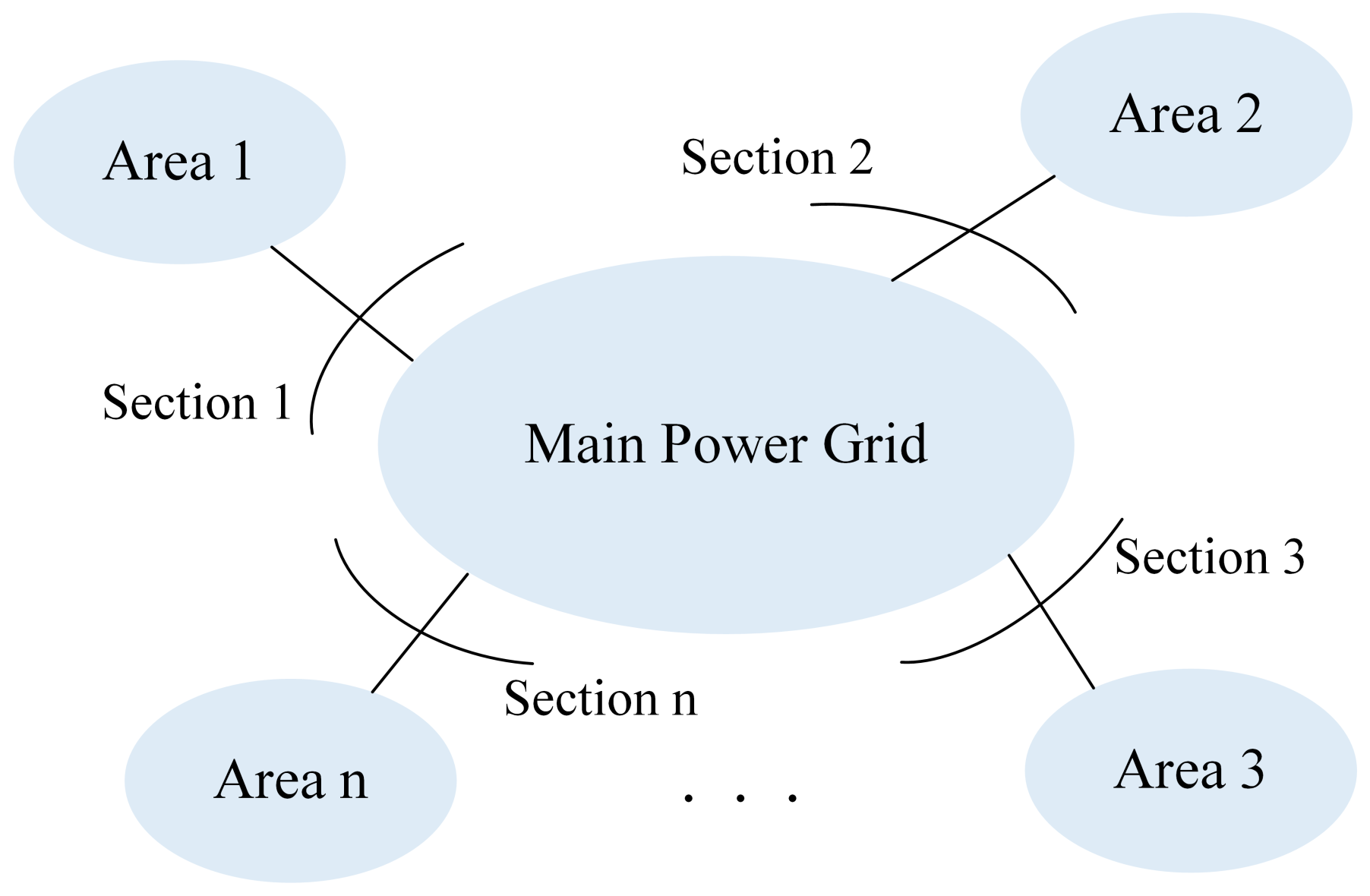
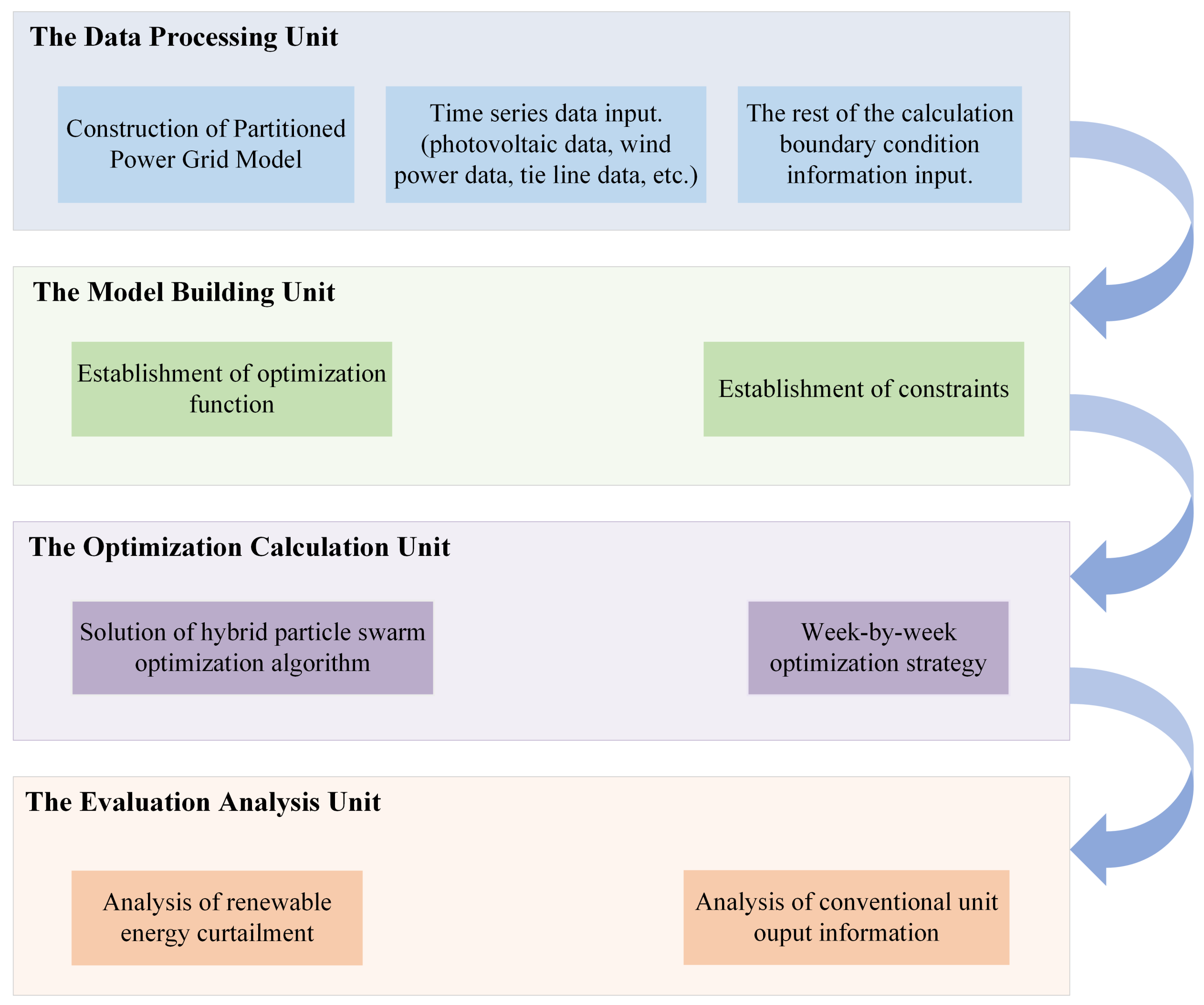
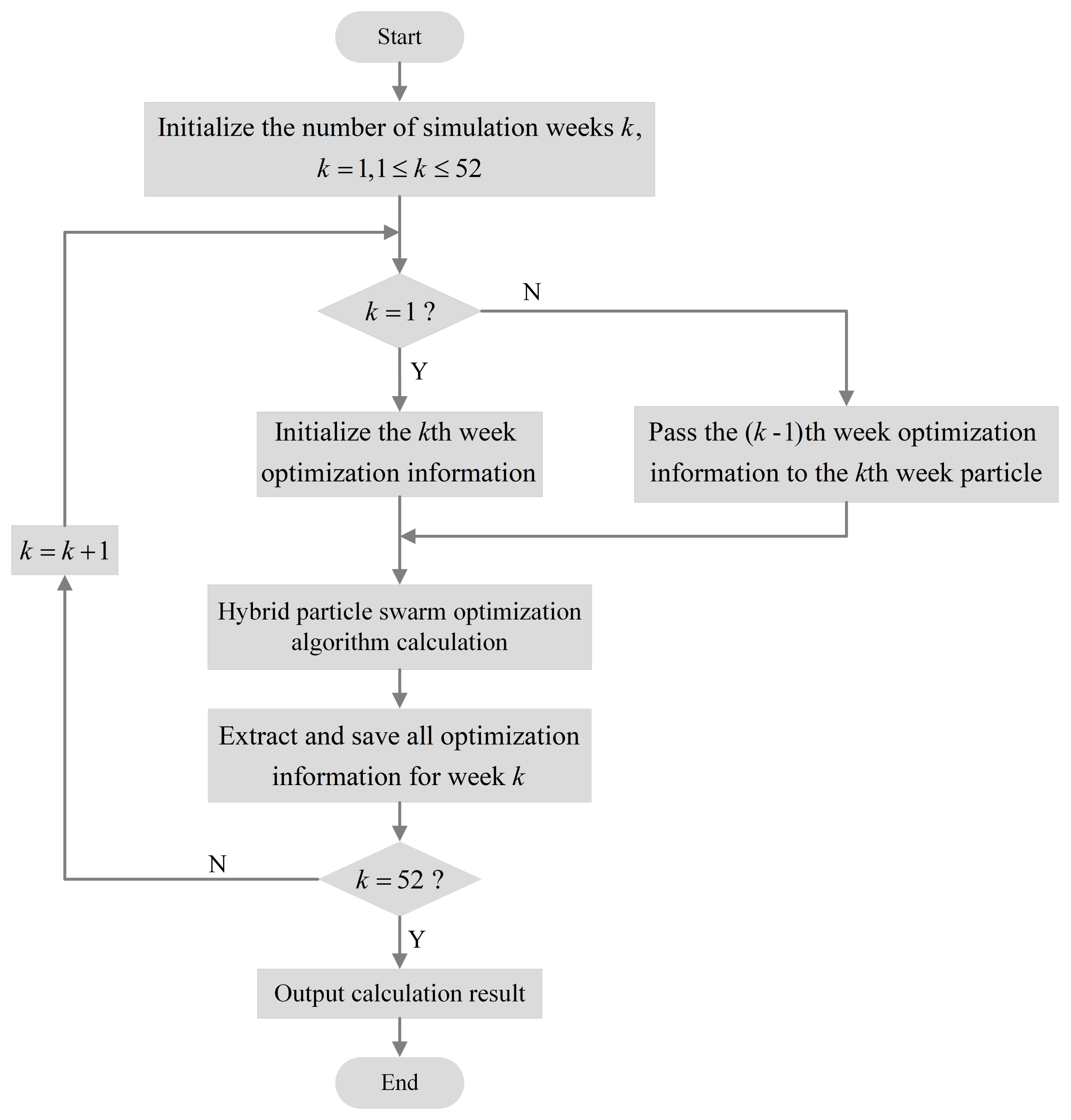
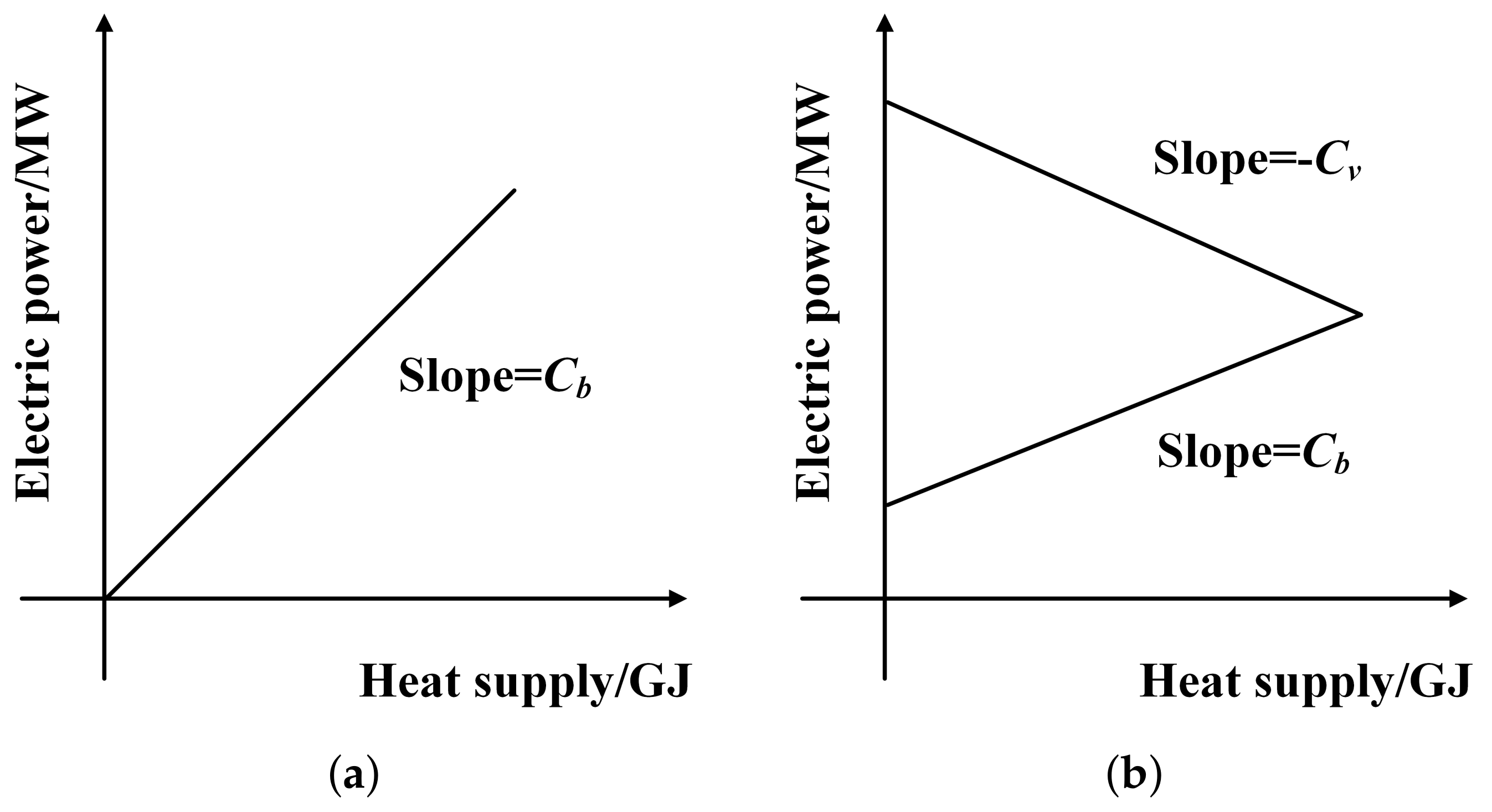
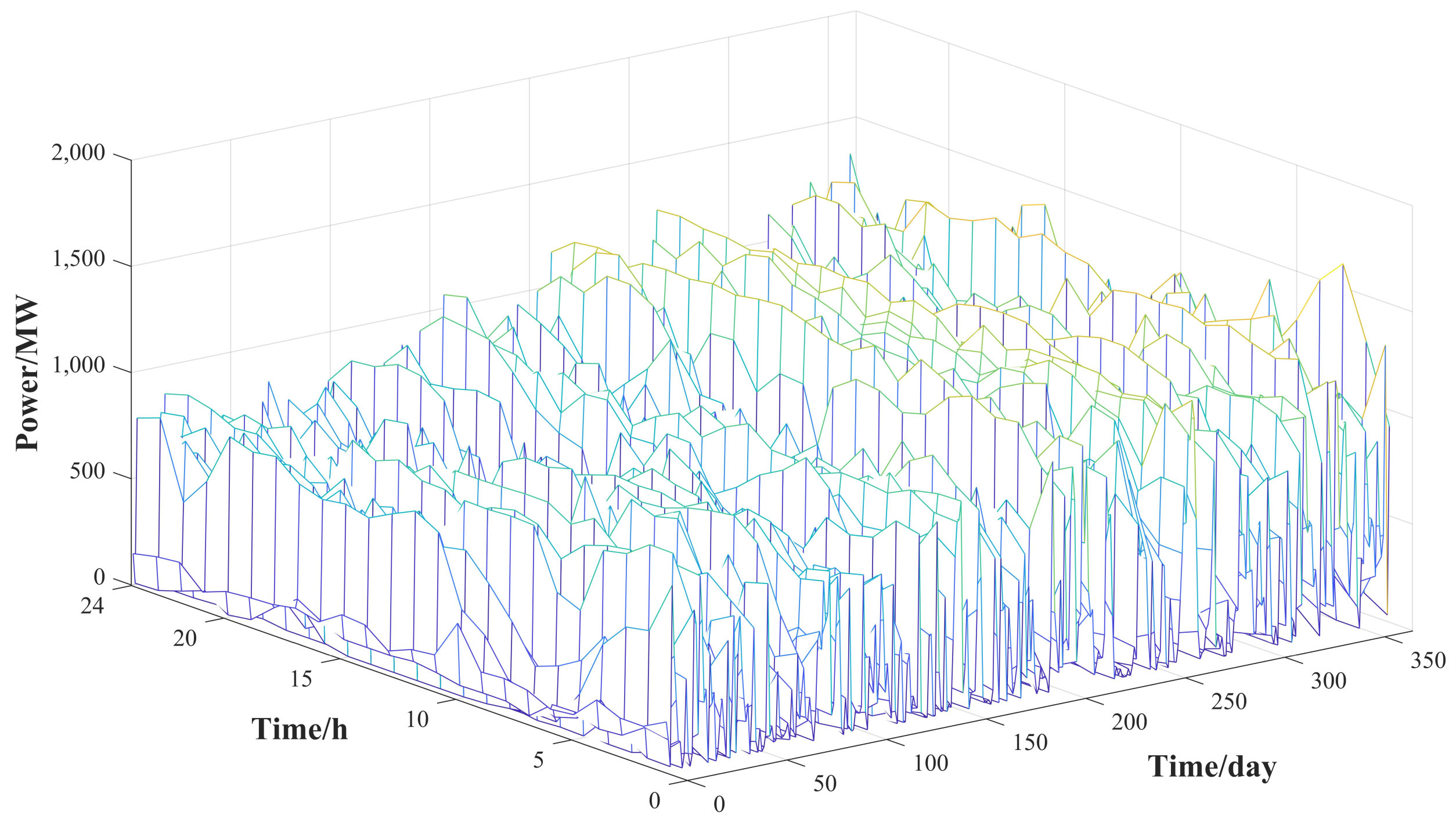
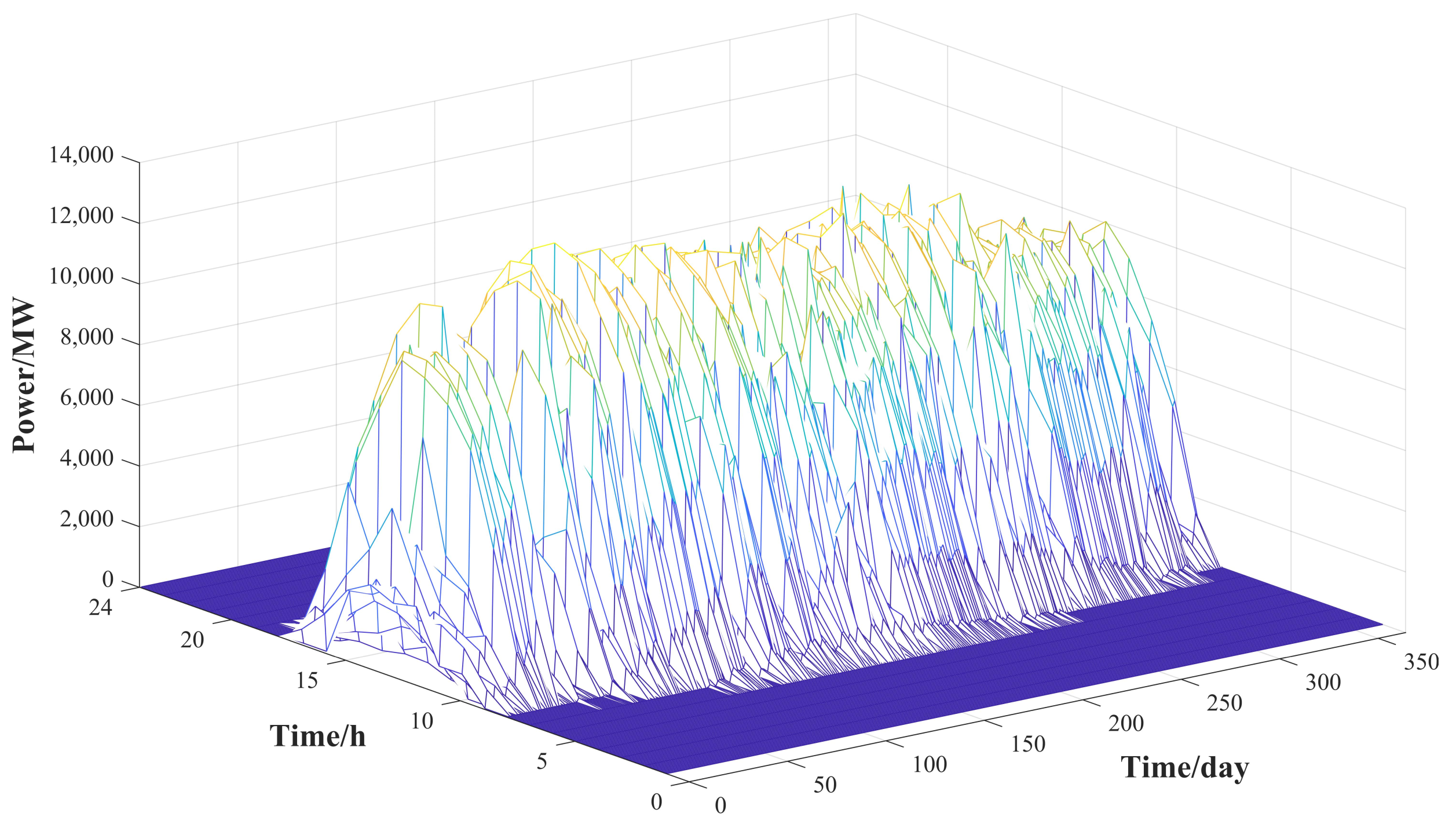
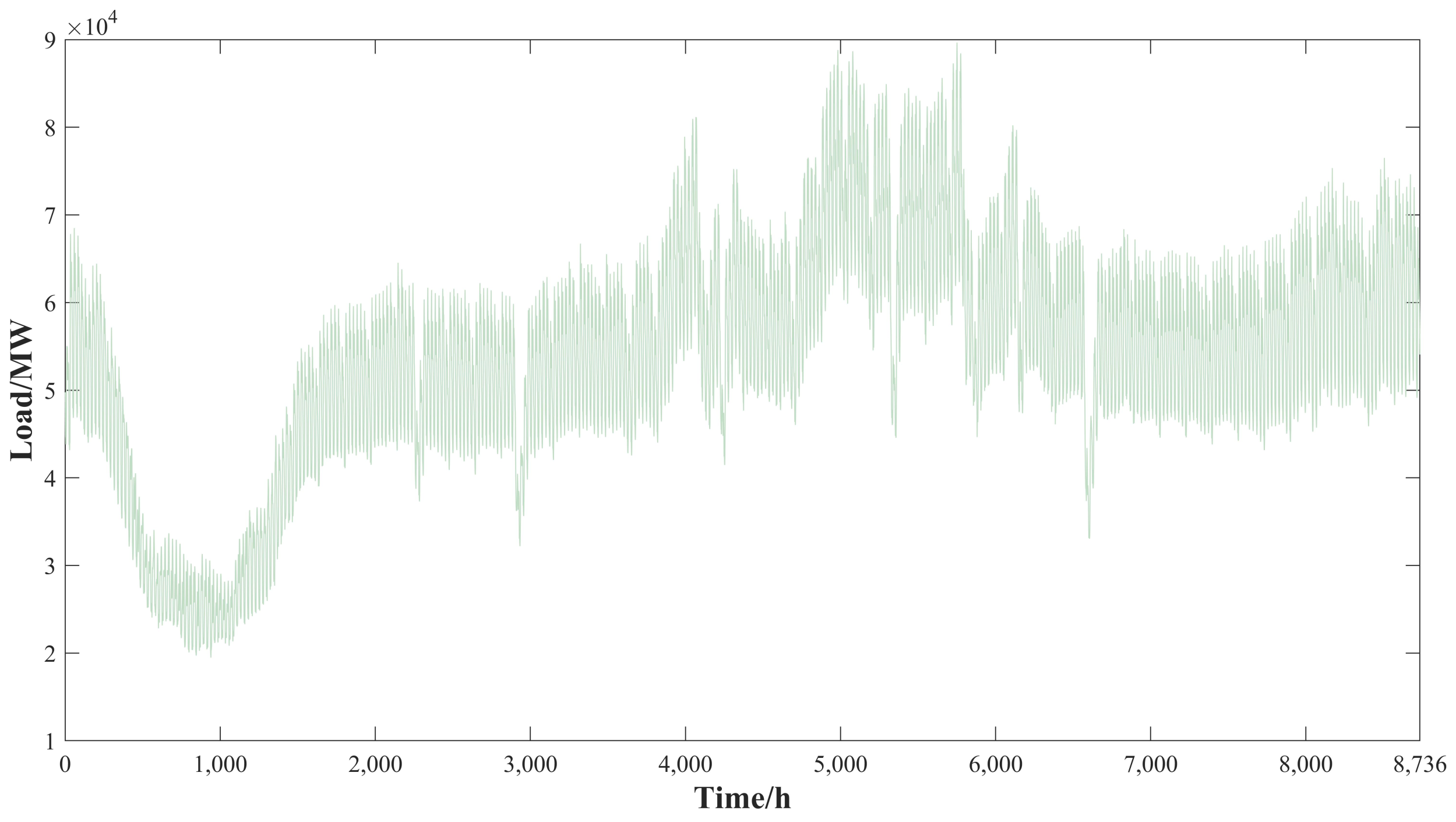
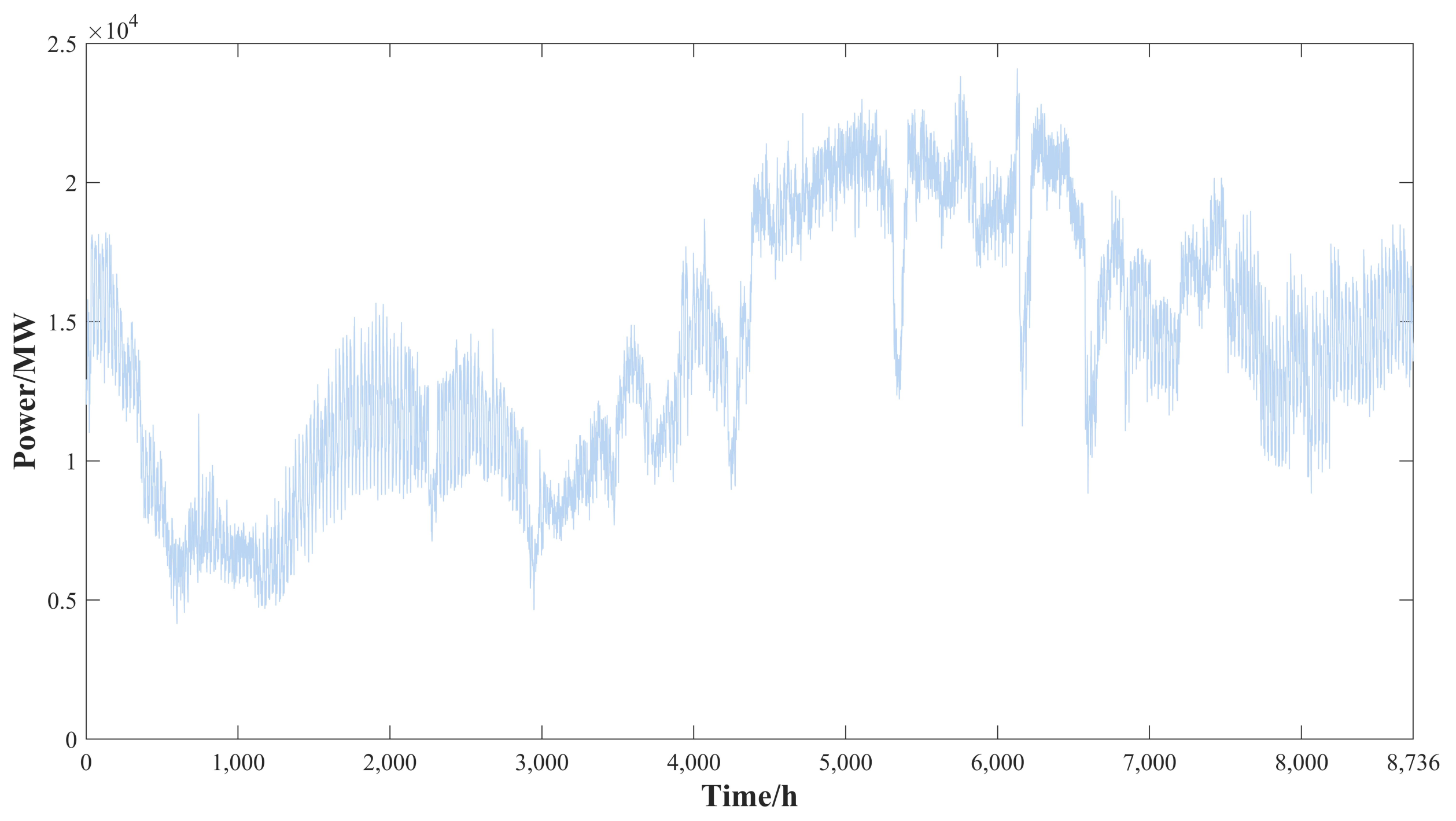




| Boundary Conditions | Calculation Conditions |
|---|---|
| System spare capacity | The positive and negative reserve capacities are 5000 MW and 1000 MW, respectively. |
| The maximum and minimum output power of the unit | According to the actual minimum operation mode, the specific data are shown in Table 2 and Table 3. |
| Wind and PV power output | The actual output of wind power and PV for one year is shown in Figure 5 and Figure 6. |
| Load | The annual actual load curve as shown in Figure 7 |
| Tie line principle | The annual actual contact line data, as shown in Figure 8. |
| Conventional unit start-up method | In this example, the unit does not set the minimum start–stop period. |
| Renewable energy restricted section limit | In this example, the power grid is calculated in one area, and there is no section limit. |
| Data Type | Thermal Power Unit I | Thermal Power Unit II | Hydroelectric Power Unit I | Hydroelectric Power Unit II |
|---|---|---|---|---|
| Number of units | 100 | 11 | 10 | 11 |
| Single-machine capacity (MW) | 600 | 300 | 600 | 100 |
| Maximum output power (%) | 100 | 100 | 100 | 100 |
| Minimum output power (%) | 50 | 50 | 20 | 20 |
| Ramp rate (MW/min) | ±60 | ±30 | ±60 | ±10 |
| Data Type | Data Name | Data Values |
|---|---|---|
| Unit information | Number of units | 16 |
| Single-machine capacity (MW) | 300 | |
| Power conversion efficiency (%) | 70 | |
| Maximum output power (%) | 70 | |
| Minimum output power (%) | 0 | |
| Storage capacity information | Initial storage capacity (MWh) | 0 |
| Maximum storage capacity (MWh) | 10,000 | |
| Minimum storage capacity (MWh) | 0 |
Publisher’s Note: MDPI stays neutral with regard to jurisdictional claims in published maps and institutional affiliations. |
© 2022 by the authors. Licensee MDPI, Basel, Switzerland. This article is an open access article distributed under the terms and conditions of the Creative Commons Attribution (CC BY) license (https://creativecommons.org/licenses/by/4.0/).
Share and Cite
Zhou, D.; Zhang, Q.; Dan, Y.; Guo, F.; Qi, J.; Teng, C.; Zhou, W.; Zhu, H. Research on Renewable-Energy Accommodation-Capability Evaluation Based on Time-Series Production Simulations. Energies 2022, 15, 6987. https://doi.org/10.3390/en15196987
Zhou D, Zhang Q, Dan Y, Guo F, Qi J, Teng C, Zhou W, Zhu H. Research on Renewable-Energy Accommodation-Capability Evaluation Based on Time-Series Production Simulations. Energies. 2022; 15(19):6987. https://doi.org/10.3390/en15196987
Chicago/Turabian StyleZhou, Dan, Qi Zhang, Yangqing Dan, Fanghong Guo, Jun Qi, Chenyuan Teng, Wenwei Zhou, and Haonan Zhu. 2022. "Research on Renewable-Energy Accommodation-Capability Evaluation Based on Time-Series Production Simulations" Energies 15, no. 19: 6987. https://doi.org/10.3390/en15196987
APA StyleZhou, D., Zhang, Q., Dan, Y., Guo, F., Qi, J., Teng, C., Zhou, W., & Zhu, H. (2022). Research on Renewable-Energy Accommodation-Capability Evaluation Based on Time-Series Production Simulations. Energies, 15(19), 6987. https://doi.org/10.3390/en15196987






